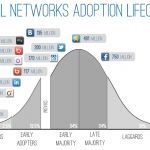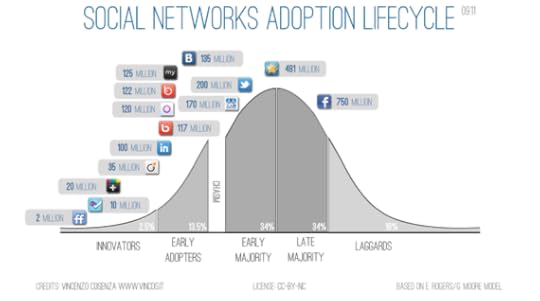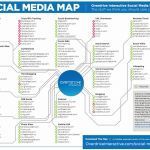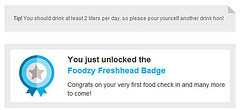Erik Qualman's Blog, page 688
August 15, 2011
Social Network Adoption Infographic

If you love the work of Italy's Vincenzo Cosenza (we certainly do!) below is his latest infographic on Social Networks Adoption via a bell curved distribution (click to enlarge):
From Cosenza's article:
The diffusion of new technologies follows a classic normal distribution or "bell curve" and, according to Everett Rogers' studies (Diffusion of Innovation, 1962), anyone who engages with a given innovation fits into one of five categories: innovators (2.5% of the potential population of adopters), early adopters (12.5%), early majority (34%), late majority (34%), laggards (16%). Each of these groups has unique psychographic characteristics that cause people to be more or less likely to adopt a given technology at a particular point in time. To understand the model you need to focus on the area under the curve that represents the percentage of adoption within each group.
The rate of adoption is defined as the relative speed with which members of a social system adopt an innovation. It is usually measured by the length of time required for a certain percentage of the members of a social system to adopt an innovation.
Later Geoffrey Moore (Crossing the Chasm, 1991) proposed a variation on Rogers' model. He suggested that for discontinuous or disruptive innovations, there is a gap or chasm to cross between the first two adopter groups (innovators + early adopters) and the early majority.
I've tried to apply this model to the diffusion of social networking sites (SNS) with the aim of plotting their actual state and, hopefully, understanding their future trajectories. To determine the rate of diffusion of each social network I've divided the number of registered users by the number of potential adopters (1 billion in my assumption).
In the innovators area we can place Friendfeed, which unfortunately stopped innovating after its acquisition by Facebook; Foursquare, the most famous location based social network with 10 million users; and Google+ with its explosive adoption rate (20 million users in 3 weeks).
In the early adoption stage we find professional social networks like Viadeo and LinkedIn, or generalist ones like Orkut (owned by Google), VKontakte (leader in Russian territories), Bebo. Badoo is the only service specifically designed for dating purposes. MySpace, after reaching the early majority is now struggling for conquering a niche (it fell from 225 million users to 125 million because of several management mistakes and Facebook's rise).
RenRen, the most important Chinese real-name SNS, and Twitter were able to successfully cross the chasm and reach the early majority. Meanwhile QZone, China's largest nickname network built on the back of Tencent's QQ Messenger, is entering the late majority area.
Lastly, Facebook the social network that has conquered the masses seems determined to hit the one billion users mark.
From now on I will try to collect social media statistics in order to periodically update the adoption lifecycle model. Please share and help me to improve my research.
[image error]
August 12, 2011
HBO releases shows on Apple & Android

[image error]HBO has officially launched its mobile MAX GO app for Apple and Android. Additionally, the mobile app is available on numerous smartphones using Google's Android™ operating system. The app is free of charge to Cinemax subscribers and offers unlimited access to over 700 hours of programming.
"Consumers will be able to watch the full suite of Cinemax's offerings and catch every action-packed moment of their favorite Cinemax movies and series anywhere they go." said Eric Kessler, co-president, HBO.
Consumers will have instant access to hundreds of Hollywood hit movies, indies, cult favorites, the MAX After Dark series as well as new and exclusive, primetime high-impact drama series like STRIKE BACK.
MAX GO is currently available to Charter, Cox Advanced TV, Verizon FiOS, AT&T U-Verse, Suddenlink, DIRECTV and DISH Network customers who subscribe to the service.
[image error]
August 11, 2011
Japan Social Outreach from Amex

American Express launched "Friends of Japan," its first-ever global social media program on Facebook. The program is designed to reignite attention and support for earthquake relief efforts, by introducing a social, word-of-mouth campaign that builds upon previous contributions and fundraising activities by Amex since the disaster struck five months ago. I'd argue this is world-of-mouth and it's nice to see a company like Amex leveraging social media for social good.
Leveraging Facebook's global platform, combined with American Express' growing international footprint, the campaign encourages people from around the world to share messages of hope through the Amex Facebook page (facebook.com/americanexpressjapan) and activate their own social networks in support of this cause. American Express will donate $1 for every message of hope posted to Japan Platform, an intermediary non-governmental organization that supports various relief agencies active in the affected areas.[image error]
The "Friends of Japan" Facebook tab is translated into 10 languages to encourage as much global participation as possible, will be actively promoted on Amex's 16 international Facebook pages and supported by a 14-market Facebook advertising campaign. Amex most recently worked with Facebook to launch its "Link, Like, Love" deals platform for card members.
[image error]
August 9, 2011
Social Media Tools Map

Our good friends at Overdrive Interactive released their most recent social media tools map (below).
While no map is perfect (e.g., include some of the Chinese social sites like Renren & Kaixin, consider removing Bebo, include Sysomos and Awareness in tracking tools, Spotify or ping for music, etc.). Overall this Map rocks as a nice pocket-guide for what's happening on the social Web. And, you can't include everything otherwise it wouldn't fit into your pocket. I've include an image from Mashable below on the Chinese social networks. Congrats to Overdrive Interactive for being named 2010 Interactive Agency of the Year.
[image error]
As Facebook and Twitter are blocked in China; these are the major Chinese Social Networks (source: Mashable)
[image error]
August 8, 2011
Would you eat a carrot to earn a badge?
As an on again, off again dieter I was intrigued to find Foodzy. When you sign up to Foodzy (it's free, but there is also a paid version) you win badges for certain good or fun eating habits. Like eating plenty of carrots. Or having cake on your birthday.
I just joined and added the chicken I had for supper to my profile, and guess what? I unlocked a badge – the Foodzy Freshhead badge, below….

Plus, I got a message telling me to drink more water….. Hmmm I understand that everyone is getting into gamification, but really? I can't say that the fact I got this badge makes me want to go onto to eat a carrot or drink the 2 liters of water to get another – would you?
However, I've just seen that there is a hangover badge to earn – now we're talking, that is much more up my street, and very easy to achieve, but that's not really healthy is it? I thought this was about good eating habits….
If you are hardcore into games, and enjoy the challenge of collecting badges then this is for you. For me I have to say if I want to eat healthily I need someone blocking the fridge! A badge just won't cut it!
The added incentive with this site is that you can compete against friends, but again I can see that getting old VERY quickly… maybe to be a Foursquare/Gowalla badge hunter you need to be a certain type of person – which I'm not. Are you?
Do you think you'd use Foodzy to keep track of what you eat? Will a badge for a carrot spur you on? I'd love to know if it's just me who's not a badge collector….
[image error]
August 5, 2011
News = Most Re-tweets (infographic)

The following infographic was produced by Dan Zarrella author of The Facebook Marketing Book . I love #3: Stop Talking About Yourself.
. I love #3: Stop Talking About Yourself.
[image error]
August 4, 2011
Smartphone Addiction: Good or Bad?

It seems like nowadays people can't go anywhere without their smartphones. Whether its checking the weather, e-mail, bank account, or Facebook updates, smartphones have made mobile connectivity so accessible that today's younger generations seem much more "addicted" to their smartphones.
[image error]
photo courtesy of: sxc.hu
According to Erica Swallow, associate editor of Mashable, the United Kingdom has declared itself a "smartphone-addicted" country. Ofcom, a UK telecommunications regulator, released the following statistics as part of their study on smartphone usage in the UK:
37% of adults and 60% of teens admit they are highly addicted to their smartphones.
51% of adults and 65% of teens say they have used their smartphone while socializing with others.
23% of adults and 34% of teens have used their smartphones during mealtimes.
22% of adult and 47% of teens admitted using or answering their smartphone while in the bathroom
I'm all for being connected in a new media world, but when does all of this connectivity become a technology overload? If 34 percent of teenagers are using their smartphones during mealtimes, where are their manners? Are they using textonyms to ask if they can be excused from the table?
[image error]
photo courtesy of: sxc.hu
James Thickett, Ofcom director of market research said, "Smartphones are changing social etiquette, and technology is now driving our values."
It's not just teenagers that are becoming addicted to their smartphones, many adults can be found in this same category.
So how do you measure yourself on your smartphone addiction?
Experts say there are a few signs that would classify you as an "addict."
The first sign is if you check your phone constantly, not necessarily for missed calls, but text messages, status updates, e-mails, push notifications, etc.
Second, your checking becomes so frequent you develop "checking habits" or the urgency to update or check certain applications such as Facebook, but within 10 minutes of each other. Most "checks" don't last more than 30 seconds, but it's the constant glancing down at your phone screen that classifies under this behavior.
Third, you can't roam around your house or office without having your phone with an arm's reach.
Another sign of possible addiction is not being able to leave home without your phone. Some people describe it as "being lost" without their phones.
In a world where media and technology continue to drive the propellers of communication, the statistics mentioned above will continue to increase. We as a society must recognize this and hold steady in our values, but embrace technology and create a balance between the two.
For example, limiting teenagers to their cell phone usage at home and especially at the dinner table creates a sense of stability between their need to socialize and the parent's need to teach their children discipline and spend quality time with them.
Another example for an addict is, [you already know who you are] first off, admit it. Secondly, recognize that sometimes being without a cell phone signal can be a blessing.
Like all things in life, maintaining balance, especially in an ever-changing-socialnomic-world, is key.
[image error]
Shaq's Twitter Legacy

Anyone that tunes in to ESPN Sportscenter can see how drastically athletes on Twitter have changed reporting. I think back a few weeks to Shaq's retirement. As one of the most prolific basketball players of all time retired, most media coverage promoted O'Neil as not only a great player but also a media darling.
Perhaps, sports history will tell a different story. As Ashton Kutcher, Oprah, and Larry King established Twitter as a legitimate broadcast source in their respective fields, Shaq can be credited with making Twitter the largest sports bar in the world. Inadvertently, Shaq may also be credited for making the sports reporter obsolete.
As reporters spent the week gushing about how Shaq gave shout-outs to his favorite members of the press, like Stephen A. Smith during his press conference, did anyone notice how many interviews active players gave regarding Shaq's retirement? Shaq played on teams for 6 franchises with the best player's of our time including Kobe, Lebron, Nash, Dwade, KG, Pierce, Allen, Stoudemire, Hill, Malone, Payton,…… ESPN asked some of our clients for interviews and reporters had zero access to players. The reason was simple…. Twitter. Player's generated their own 140 character or less official statements and ESPN ran screenshots of those statements around the clock. SCREENSHOTS! Instead of interviewing players on air, news channels re-purposed hours-old tweets instead. Today, we receive often incoherent, impulsive 140 character statements, directly from players to millions of fans instantly.
If video killed the radio star, surely the accountants in Bristol are counting the money they will save now that Twitter killed the sports reporter. Salaries, medical benefits, paid vacations, and for what?….so that when news hits ESPN, reporters have inside access. Now a Twittertern and a high-school level writer can feed the story to a broadcaster and journalism is reduced to a stream of tweets with mind-numbing commentary.
This new way of reporting will change over time and true sports fanatics will want more than just a tweet about important stories. But in the meantime, there is at least one group of people who are ready to join the "Big AARP." Watch out grandma, they'll be a lot more journalist playing scrabble at the home next week.
[image error]
August 3, 2011
Matt Damon Defends Teachers in Heated Exchange

We have to live as if our mother is watching us. This is a difficult concept for athletes and celebrities to comprehend. Matt Damon defends teacher tenure in the below clip and things get heated quickly. Ironically his mother is right there watching as he unleashes a few explicative words.
(Video: Watch this video on the post page)
Now, only after a few days it has over 300,000 views on YouTube and growing. Notice the citizen journalism when the Flip Camera gets pulled out (I still don't understand why Cisco killed the Flip product line).
Recommended Book: Likeable by Dave Kerpen
[image error]
Matt Damon defends teachers and the exchange gets heated
[image error]
Matt Damon Defends Teachers in Heated Exchange @$#!

We have to live as if our mother is watching us. This is a difficult concept for athletes and celebrities to comprehend. Matt Damon defends teacher tenure in the below clip and things get heated quickly. Ironically his mother is right there watching as he unleashes a few explicative words.
(Video: Watch this video on the post page)
Now, only after a few days it has over 300,000 views on YouTube and growing. Notice the citizen journalism when the Flip Camera gets pulled out (I still don't understand why Cisco killed the Flip product line).
Recommended Book: Likeable by Dave Kerpen
[image error]
Matt Damon defends teachers and the exchange gets heated
[image error]



